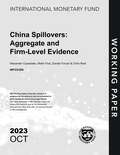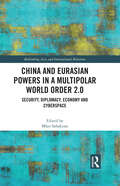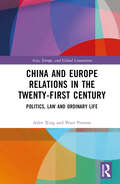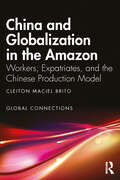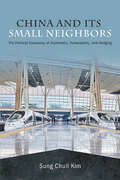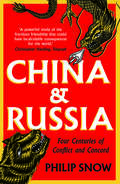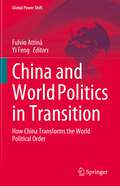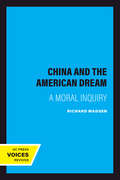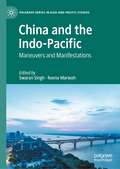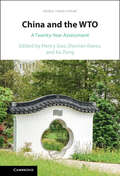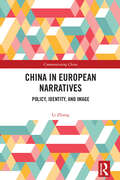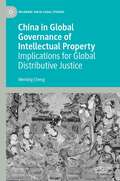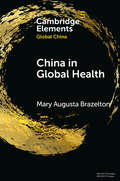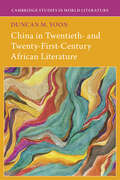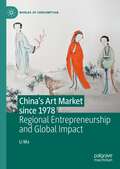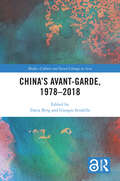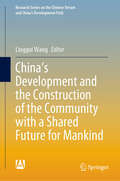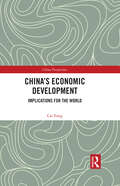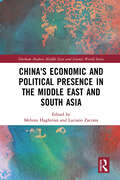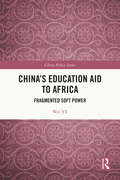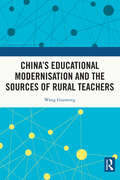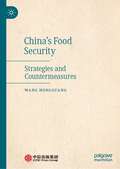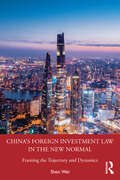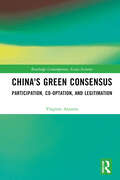- Table View
- List View
China Spillovers: Aggregate and Firm-Level Evidence (Imf Working Papers)
by RedlA report from the International Monetary Fund.
China and Eurasian Powers in a Multipolar World Order 2.0: Security, Diplomacy, Economy and Cyberspace (Rethinking Asia and International Relations)
by Mher SahakyanThis book argues that the world order is no longer unipolar, and the war in Ukraine proves this fact. As this study describes and theorizes, it has been transformed into a Multipolar World Order 2.0 stage. This title critically examines Chinese, US, Russian, EU, Indian, and a number of other powers’ cooperation and competition over security, diplomatic, economic and cyberspace issues. Accomplished scholars from various regions of the Eurasian continent consider the impact of the Russo–Ukrainian war, the Sino–Russian strategic partnership, China’s relations with the United States and the European Union, the influence of the Belt and Road Initiative, the expansion of the Shanghai Cooperation Organization and Eurasian Economic Union, China’s policies in the Middle East, Central Asia, Indo-Asia Pacific, the South Caucasus, Central and Eastern Europe, as well as focus on details of growing contradictions and collaboration in the Eurasian continent over markets, technologies, digital leadership, vaccine distribution, and financial institutions in the Era of Multipolar World Order 2.0. Showing that the US-centred unipolar world order is replaced by Multipolar World Order 2.0 where conflicting powers fight to keep or extend their spheres of influence, this volume is of great interest to decision makers, diplomats, scholars and students of international relations, politics, global governance, Eurasian studies, Chinese studies, cybersecurity, and economics, and for those studying human security, international organizations, and geopolitics.
China and Europe Relations in the Twenty-First Century: Politics, Law and Ordinary Life (Asia, Europe, and Global Connections)
by Peter Preston Aifen XingThis book argues that although relations between China and Europe are strained in many areas, including trade, human rights and views about political systems, nevertheless established linkages, especially when considered in the context of long-term historical linkages, development trajectories and intellectual cultures, offer good prospects for future progressive collaborative exchanges. Approaching the subject in a balanced way, giving equal weight to the perspectives of both sides, the book examines China and Europe’s shared experiences of age-old civilizations, of the disorienting effects of the economic, social and political upheavals triggered by the late eighteenth century creation of the modern world, and of the nineteenth and early twentieth centuries era of European empires, warfare and the Cold War. It contends that although China and Europe appear superficially to have followed different paths, with many problems in their relationship resulting, they in fact have a very great deal in common concerning how they have coped with the long shift from ancient civilizations to the modern world of natural-science-based industrial capitalism.
China and Globalization in the Amazon: Workers, Expatriates, and the Chinese Production Model (Global Connections)
by Cleiton Maciel BritoChina and Globalization in the Amazon examines Chinese investment in the Global South, with particular attention to industrial activity in Latin America. Based on ethnographic work conducted in several Chinese factories in the Amazon region of Brazil, whether private, partially private, or state-owned, it explores the impact of these factories on the lives of workers, specifically on wages, laws, and labor benefits, as well as the relationship between management and workers. Drawing on interviews with Brazilian workers, expatriate Chinese workers, union leaders, and factory managers, the author identifies a Chinese production model and sheds light on the implementation of externally defined work regimes that showed little engagement with the workforce in the region, together with practices that resulted in a technical or bureaucratic relationship with the worker, and the emergence of lower wages than the local average, as well as few concessions on labor benefits. A study of Chinese globalization and industrial expansion in the developing world, and the reactions of workers to the Chinese model of management, this volume will be of interest to scholars of the sociology of work and organizations, globalization, development studies, and politics.
China and Its Small Neighbors: The Political Economy of Asymmetry, Vulnerability, and Hedging
by Sung Chull KimIn China and Its Small Neighbors, Sung Chull Kim examines the political implications of the economic asymmetry between China and its small neighbors, part of wider changes in international relations brought about by the rise of China. While being critical of the current trend that focuses on the China-U.S. rivalry alone, Kim argues that a microanalysis of China's advances toward its neighbors is a guide to understanding the trajectory of China's expanding influence and transitions in world politics more broadly. Economic asymmetry—as seen in trade concentration, non-transparency, and reliance on bilateral aid—has made China's small neighbors vulnerable on the political front, thus generating potential threats to their sovereignty and independence. Because China has the upper hand in the bilateral relationships, these weak states practice dual-core hedging as a strategy for survival. They hedge on China for expected economic benefits and at the same time hedge against their powerful neighbor to mitigate the risks involved in that hedging-on. Each small state's mode of hedging depends on its degree of vulnerability and its availability of policy instruments such as multilateral institutions and bilateral partnerships with extra-regional powers.
China and Russia: Four Centuries of Conflict and Concord
by Philip SnowA compelling, expansive history of the relationship between China and Russia, from the seventeenth century to the present Russia and China, the largest and most populous countries in the world, respectively, have maintained a delicate relationship for four centuries. In addition to a four-thousand-kilometer border, they have periodically shared a common outlook on political and economic affairs. But they are, in essence, profoundly different polities and cultures, and their intermittent alliances have proven difficult and at times even volatile. Philip Snow provides a full account of the relationship between these two global giants. Looking at politics, religion, economics, and culture, Snow uncovers the deep roots of the two nations’ alignment. We see the shifts in the balance of power, from the wealth and strength of early Qing China to the Tsarist and Soviet ascendancies, and episodes of intense conflict followed by harmony. He looks too at the experiences and opinions of ordinary people, which often vastly differed from those of their governments, and considers how long the countries’ current amicable relationship might endure.
China and World Politics in Transition: How China Transforms the World Political Order (Global Power Shift)
by Yi Feng Fulvio AttinàThis book analyzes China's transformative political power in today's world while simultaneously addressing global issues and the reformation of world institutions. China has become known as the world's first factory and trading power, but more knowledge on China's rise is necessary to understand the world of today and the future. The main question is where China's rise is headed and how this affects the increasingly connected world that faces problems that no state can effectively address on its own. This book analyzes both sides of the coin, that is, the problems of a world scale and the change of the world political order. China is among the major actors for global issues such as mitigating climate warming, controlling weapons of mass destruction, combating economic inequality and underdevelopment, and improving health for all. In the current setting of the new world order, all countries and especially world powers develop a general blueprint for the future, as cultural and material conditions of the present world are very different from the past. Under such conditions, China faces a review of its bilateral and regional strategies, as well as its position and actions in world institutions that have the mission of forming policy responses to issues of a global scale.This book, therefore, provides insight into China's view of world problems and the future world order. It is a must-read for everybody interested in a better understanding of China's role in today's world and the global power shift.
China and the American Dream: A Moral Inquiry
by Richard MadsenFrom the "Red Menace" to Tiananmen Square, the United States and China have long had an emotionally tumultuous relationship. Richard Madsen's frank and innovative examination of the moral history of U.S.-China relations targets the forces that have shaped this surprisingly strong tie between two strikingly different nations. Combining his expertise as a sinologist with the vision of America developed in Habits of the Heart and The Good Society, Madsen studies the cultural myths that have shaped the perceptions of people of both nations for the past twenty-five years.The dominant American myth about China, born in the 1960s, foresaw Western ideals of economic, intellectual, and political freedom emerging triumphant throughout the world. Nixon's visit to China nurtured this idea, and by the 1980s it was helping to sustain America's hopefulness about its own democratic identity. Meanwhile, Chinese popular culture has focused on the U.S., especially American consumer goods—Coca-Cola was described by the People's Daily as "capitalism concentrated in a bottle."Today we face a new global institutional and cultural environment in which the old myths no longer work for either Americans or Chinese. Madsen provides a framework for us to think about the relationship between democratic ideals and economic/political realities in the post-Cold War world. What he proposes is no less than the foundation for building a public philosophy for the emerging world order.
China and the Indo-Pacific: Maneuvers and Manifestations (Palgrave Series in Asia and Pacific Studies)
by Reena Marwah Swaran SinghThe book emanates from the geopolitical and geo-economic churning and transformations set in motion by the unprecedented economic rise of China resulting in its expanding political influence across the region and the world. In both the economic and the security realms, the United States and China alike are increasingly seen contesting in shaping the Indo-Pacific regional order to their own advantage. This book unfolds the contours and dimensions of China’s responses to various multilateral initiatives of the US and its friends and allies like Japan, Australia, and India and, to some extent, even ASEAN. While China’s medium-term strategy envisages a non-hostile external environment in order to focus on domestic priorities; reducing dependence of littoral nations of the Indo-Pacific region on America while increasing their engagement and dependence on China. China's expanding reach and influence overseas has resulted in US-led initiatives being China-focused inviting a response from China where adverse reactions have become increasingly palpable.
China and the West: A Pragmatic Confucian’s View
by Yao YangThis is an authored volume of Dr. Yao's “big-picture” writings on China and the West, translated by David Ownby. Those writings are selected from his writings as a public intellectual, reflecting his thought on China’s path of modernization and the effort to rebuild a political philosophy based on Confucianism, his interpretation of China’s political system and his prescriptions to improve it. A moderate, yet influential scholar, Yao's work has had great influence on Chinese social and economic policymakers; his project of renewing China's traditional value system is an important position, as Chinese reforms begin to focus on equity and inclusion. In an engaging, at times personal, and thoughtful volume, Dr. Yao's vision of a gentler Chinese society will interest Sinologists, political scientists, and journalists.
China in European Narratives: Policy, Identity, and Image (Communicating China)
by Li ZhangThis book explores how China, and especially China’s Belt and Road Initiative, is viewed in European media and by European think tanks, thereby uncovering European elites’ views of China. Looking across Europe—the European Union, Western Europe (including the United Kingdom), Central Europe, and Eastern Europe—the book reveals a complex picture, with different views in different places, and with different aspects of China disproportionately emphasized in some places. As China’s importance in the world continues to grow, it is crucial to understand how distorted views of China are shaping international relations.
China in Global Governance of Intellectual Property: Implications for Global Distributive Justice (Palgrave Socio-Legal Studies)
by Wenting ChengThis book analyses how China has engaged in global IP governance and the implications of its engagement for global distributive justice. It investigates five cases on China’s IP engagement in geographical indications, the disclosure obligation, IP and standardisation, and its bilateral and multilateral IP engagement. It takes a regulation-oriented approach to examine substate and non-state actors involved in China’s global IP engagement, identifies principles that have guided or constrained its engagement, and discusses strategies actors have used in managing the principles. Its focus on engagement directs attention to processes instead of outcomes, which enables a more nuanced understanding of the role that China plays in global IP governance than the dichotomic categorisation of China either as a global IP rule-taker or rule-maker. This book identifies two groups of strategies that China has used in its global IP engagement: forum and agenda-related strategies and principle-related strategies. The first group concerns questions of where and how China has advanced its IP agenda, including multi-forum engagement, dissembling, and more cohesive responsive engagement. The second group consists of strategies to achieve a certain principle or manage contesting principles, including modelling and balancing. It shows that China’s deployment of engagement strategies makes its IP system similar to those of the EU and the US. Its balancing strategy has led to constructed inconsistency of its IP positions across forums. This book argues that China still has some way to go to influence global IP agenda-setting in a way matching its status as the second largest economy.
China in Global Health: Past and Present (Elements in Global China)
by Mary Augusta BrazeltonMary Brazelton argues that the territories and peoples associated with China have played vital roles in the emergence of modern international health. In the early twentieth century, repeated epidemic outbreaks in China justified interventions by transnational organizations; these projects shaped strategies for international health. China has also served as a space of creativity and reinvention, in which administrators developed new models of health care during decades of war and revolution, even as traditional practitioners presented alternatives to Western biomedicine. The 1949 establishment of the People's Republic of China introduced a new era of socialist internationalism, as well as new initiatives to establish connections across the non-aligned world using medical diplomacy. After 1978, the post-socialist transition gave rise to new configurations of health governance. The rich and varied history of Chinese involvement in global health offers a means to make sense of present-day crises.
China in Twentieth- and Twenty-First-Century African Literature (Cambridge Studies in World Literature)
by Duncan M. YoonChina in Twentieth- and Twenty-First Century African Literature unpacks the long-standing complexity of exchanges between Africans and Chinese as far back as the Cold War and beyond. This scope encompasses how China, which emerged as a main engine of the world economy by the end of the twentieth century, has transformed patterns of globalization across the continent. In this ground-breaking work on cultural representations, Duncan M. Yoon examines the controversial symbol of China in African literature. He reads acclaimed authors like Kofi Awoonor, Henri Lopes, and Bessie Head, as well as contemporary writers, including Ufrieda Ho, Kwei Quartey, and Yvonne Adhiambo Owuor. Each chapter focuses on a genre such as poetry, detective fiction, memoir, and the novel, drawing out themes like resource extraction, diaspora, gender, and race. Yoon demonstrates how African creative voices grapple with and make meaning out of the possibilities and limitations of globalization in an increasingly multipolar world.
China's Art Market since 1978: Regional Entrepreneurship and Global Impact (Worlds of Consumption)
by Li MaThis book examines the rising global prominence of China’s art market throughout the twentieth and twenty-first centuries. To understand the far-reaching impact of Chinese art on global consumption, this book traces the shift from regional markets to global markets. It asks how the Chinese art market re-emerged from its politicized past, innovated within the private economy boom, remained resilient despite the global financial crisis, and flourished on the global stage despite the COVID-19 pandemic. Ultimately, it argues that cultural entrepreneurship enabled Chinese art professionals to reinvent their space and to participate in the global artworld.
China's Avant-Garde, 1978–2018 (Media, Culture and Social Change in Asia)
by Daria Berg and Giorgio StrafellaThis book examines how China’s new generation of avant-garde writers and artists are pushing the boundaries of vernacular culture, creatively appropriating artistic and literary languages from global cultures to reflect on reform-era China’s transformation and the Maoist heritage. It explores the vortex of cultural change from the launch of Deng Xiaoping’s reforms in 1978 to Xi Jinping establishing his leadership for life in 2018. The book argues that China’s new avant-garde adopt transcultural forms of expression while challenging the official discourse of Xi Jinping’s regime, which promotes cultural nationalism and demands that cultural production in China embodies the essence of the "Chinese nation". The topics range from body art, women’s poetry and boys’ love literature to Tibetan fiction and ceramic art. The book shows how the avant-garde use the new digital media to bypass government censorship, transcending China’s virtual frontiers while breaking new ground for an emerging public sphere. Overall, the book provides a rich picture of the nature of China’s avant-garde art and literature and the challenges it poses for the Chinese government.
China's Development and the Construction of the Community with a Shared Future for Mankind (Research Series on the Chinese Dream and China’s Development Path)
by Malcolm ThompsonThis book focuses on China’s experience in development over the past 70 years and its significance, as well as building a community with a shared future for mankind. The book consists of a collection of papers contributed by researchers from many countries, covering the topics of world order, a community with a shared future for mankind, “the Belt and Road” initiative, exchange and mutual learning between civilizations, China Model, China and the World, multi-bilateral relationship, sustainable development.
China's Economic Development: Implications for the World (China Perspectives)
by Cai FangCai Fang is one of China’s most distinguished economists. This book elucidates the worldwide significance of China’s economic development over the past 70 years from the perspectives of economic history and growth theory.The Chinese economy has undergone an unprecedented period of growth and development since the reform and opening-up in the late 1970s; a process which the hallmarks of neoclassic economic theory have often proved inadequate to explain. Examining the Chinese economy in the light of Chinese history and the development of the world economy as a whole, the book charts the milestones and critical reforms of China’s economic development, providing insights into unique attributes as well as more generic patterns. The discussion covers multiple hot topics in the field, including the so-called Great Divergence, dual-sector economic development, real-world experience of the reform and opening-up, rural reform, urbanization, economic reform, poverty reduction, the latter day slowdown of China’s economic growth, and China¡¯s role in and response to globalization, global supply domination and other headwinds.The book will be a must-read for students, scholars and general readers interested in the Chinese economy, economic development, political economy, and development economics.
China's Economic and Political Presence in the Middle East and South Asia (Durham Modern Middle East and Islamic World Series)
by Luciano Zaccara Mehran HaghirianThis book explores a range of key issues connected to China’s relations with countries in the Middle East and South Asia. It discusses economic and political connections, and projects which have arisen as part of China’s Belt and Road Initiative. It covers both important countries in the Middle East, and also Pakistan, Bangladesh and Afghanistan. It examines current contentious issues including Iranian sanctions and the war in Syria, and assesses the roles of other powers such as Russia, Turkey and Israel insofar as they affect China’s relationships. Overall, the book presents many new perspectives on the subject, with many of the perspectives representing the view from the countries of the Middle East and South Asia.
China's Education Aid to Africa: Fragmented Soft Power (China Policy Series)
by Wei YeChina’s rise as an aid provider in Africa has caught global attention, with China’s activity being viewed as the projection of soft power of a neo-colonialist kind in an international relations context. This book, which focuses on China’s education aid—government scholarships, training, Confucius Institutes, dispatched teachers, etc., reveals a much more complicated picture. It outlines how the divide between the Chinese Ministry of Commerce and the Ministry of Education hinders China’s soft power projection, how much of China’s aid is bound up with an education-for-economic-growth outlook, mirroring China’s own recent experiences of economic development, and how China’s aid—prioritized to reflect the commercial sector’s interests—is out of step with most international development aid, which is dominated by education agendas and the campaigns of international organizations and traditional donors; this leaves China easily exposed to the charge of neo-colonialism. This situation also reveals insufficient knowledge production of China and in South-South Cooperation. Substantial production of Southern knowledge should recognize the international development cooperation architecture as an open system by which both traditional donors and Southern countries transform.
China's Educational Modernisation and the Sources of Rural Teachers
by Wang GuomingDrawing on modernisation theory, this book charts the history and development of China’s rural education while examining the changes in rural teacher training and recruitment since the beginning of the 20th century.Highlighting the changes in the composition of the body of rural teachers after modern schools were established in rural areas in China, the author outlines and discusses several historical phases that figure in the transformation of the teaching profession, including traditional private homeschooling teachers (sishu teachers), the earliest group of teachers of new-style schools, non-government teachers, teachers trained in normal schools and substitute teachers. Based on field studies in a county in northern China, the book analyses various contributing factors in rural teacher resourcing, ranging from China’s modernisation and urbanisation, the county’s social and economic development, management systems of rural schools and teachers, and teacher training and recruiting mechanisms. It also introduces the temporary solutions and long-term plans that have been adopted and implemented in different historical periods to regenerate the rural teaching force.The title will be a useful reference for scholars, students, and policymakers interested in modern and contemporary education in China, rural teachers, and rural education.
China's Food Security: Strategies and Countermeasures
by Wang HongguangThis book makes a systematic study of the history, current situation and trend of China's food security and the global food security. COVID-19 has triggered a world food crisis. Understanding the history, current situation and trend of China's and global food security is conducive to the rational arrangement of agricultural production, food storage, scheduling and import by management departments; it is conducive to the understanding of the situation of food supply and demand; it is conducive to the rational arrangement of production and operation planning. This book systematically studies the history and experience of China's food security, analyzes the 9 major problems facing the current food security, calculates the potential food production, puts forward the strategies and countermeasures for food security in the next 20 years and puts forward 4 strategies and 8 countermeasures for ensuring food security. This book will be of great value to scholars of international relations and sinologists, and has special relevance to United Nations sustainable development goal 2, eliminating hunger.
China's Foreign Investment Law in the New Normal: Framing the Trajectory and Dynamics
by Shen WeiThis book analyzes China's foreign investment law which came into force in January 2020. The new law implemented sweeping changes and overhauled China’s foreign investment law regime of the last four decades. The foreign investment law aims to make the business environment more investor-friendly and address some of the contentious issues between US and China in the ongoing trade war. The book explains how the law enhances regulatory transparency. It also outlines the new approval process, that is the pre-establishment negative list system which has replaced the former approval system for foreign investment projects. This book will help give readers a better understanding of major changes and benefits under the new law and will be the first of its kind looking at the implications of this law.
China's Green Consensus: Participation, Co-optation, and Legitimation (Routledge Contemporary Asian Societies)
by Virginie ArantesDespite contrasting approaches, democratic and authoritarian governments all underline the fact that environmental protection is crucial and inevitable—and China’s enthusiasm in stepping up its efforts to protect the environment has not gone unnoticed. This book highlights how the consensual orchestration of sustainability in China’s biggest city, Shanghai, affects non-state actors’ ways of perceiving, acting, and organizing around environmental issues. China’s Green Consensus examines grassroots realities as they intersect with events of everyday life, offering insights into areas that far transcend debates over coercive forms of environmentalism and exploring the “soft” and “green” facets of President Xi Jinping’s authoritarian approach to governance. The importance of environmental protection in people’s lives serves as a lens to analyze and understand authoritarian adaptations to environmental global phenomena. Arantes highlights how, through mobilization and (de)politicization, a “green” consensus leads to the displacement of state responsibilities and the cultivation of civil society in its own image. In so doing, she opens up new ways of thinking about the complexities of environmental governance, consensus politics, subject making, and citizenship in authoritarian contexts. This book will be of interest to scholars and students of Chinese society and politics, environmental politics, political ecology, international relations, and urbanization in Asia, as well as all others interested in the rising appeal of authoritarianism around the globe.
